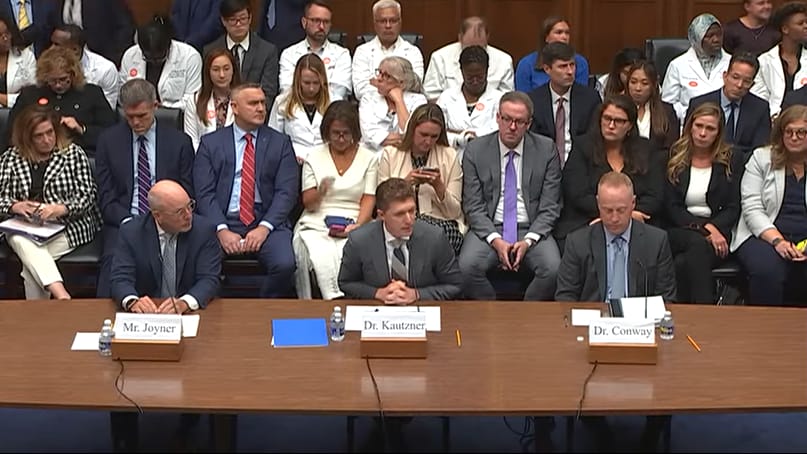If you want to search Cost Curve back issues or link to anything you read here, the web links and archive are online at costcurve.beehiiv.com. You can subscribe there, too.
There was a big House Oversight hearing featuring PBM leaders yesterday, and I feel like I should be more engaged than I am. I realize it’s Hot PBM Summer (cue the Ciaccia fireman/arsonist comment), and yet …
Maybe its just a midsummer malaise, but I can’t shake the impression that we’re in “he’s already dead” territory on the PBM issue. Between the FTC report, the flow of other research, and the Oversight report that dropped yesterday, the question is now not so much, “Do PBMs have questionable business practices?” but rather, “What are we to do about that?” And the Oversight meeting didn’t really hit that element.
(House Oversight provided a nice summary of the event, if you’d like to catch up. FWIW, Endpoints declared in its headline that the execs “dodge[d] grilling,” if you’re really curious how it went down. )
There are a number of bills percolating that tackle the issue with varying levels of seriousness, and we can add one more to that list: Reps. Jake Auchincloss and Diana Harshbarger dropped their PBM reform bill yesterday. It’s on the “serious” side of the spectrum, but I assume the question now is about process and politics — what can actually get done in a city that’s about to go into full-on election mode — as much as anything.
***
It’s worth pausing here, amidst all of the talk about how money flows through the health care system and whether PBMs are holding on to more it than they deserve, to ground ourselves in the reality that the health care system is not some theoretical financial construct.
It’s not the bond market. This is a system about healing the sick. At the end of the day, it’s about people.
So let me link to this story about a patient who was discussed at yesterday’s hearing. Fifteen-year-old Mattie McKoy requires Pulmozyme to keep his airways free of mucous, and his insurance company denied the drug. I don’t want to delve into the decision-making process here or point fingers. Just wanted to make sure that the human context to all of this doesn’t get lost.
One of the recurring themes around prescription drug affordability boards is that the mechanics of assessing a drug’s “affordability” is a really hard process. We saw that crop up in Colorado, where there were concerns raised about the underlying data being used.
In Maryland, members of the PDAB raised concerns this week about the pace of their work. Per a Maryland Matters story, board members are pointing out that they’re still in the thick of things when it comes to assessing the data on the six medicines selected for additional review, yet they only have two more meetings this year … and that their findings still need to be endorsed by the state’s General Assembly.
In short, they’re finding that the process is too complicated to be carried out expeditiously. While industry probably views this as good news, the objective take here may be that this is just the kind of endeavor that is too onerous for states to take on.
Say what you will about the Inflation Reduction Act, but the folks who drafted that knew that making judgments about drug price and value is no simple undertaking, which is why they reserved a whopping $3 billion to administer the price control element of that law.
Copays are a mysterious concept: they’re intended to give patients “skin in the game” and create incentives not to overconsume care. But we’re not seriously worried about the overconsumption of cancer meds or insulin or whatever, are we? And if we’re not, all copays do is create financial barriers. Anyway: No Patients Left Behind has a great ad out hamming home that point, in the context of asthma. Check it out, and like, share, etc.
Look, I don’t want to say that this research — finding that the USPTO erroneously extends pharma/device patents about 4% of the time (by an average of about 12 weeks) — is unimportant. But I’m impressed that the authors were able to spin that into a Nature Biotechnology publication and an 800-word STAT story. If you’re curious: yes, this was a Harvard PORTAL-led effort funded by Arnold Ventures. Say what you will about those folks: they know how to drive attention to their work.
Adam Fein has pulled together data from the 10 companies that have reported 2023 list/net price changes. I think we’ve talked about all 10 of them here over the past three or four months, but Adam does a great job of pulling it all together. We’re still short one pricing transparency report: Janssen’s grand compendium. Looking forward to that one dropping.
Thanks for reading this far. I’m always flattered when folks share all or part of Cost Curve. All I ask is for a mention or tag. Bonus points if you can direct someone to the subscription page.





